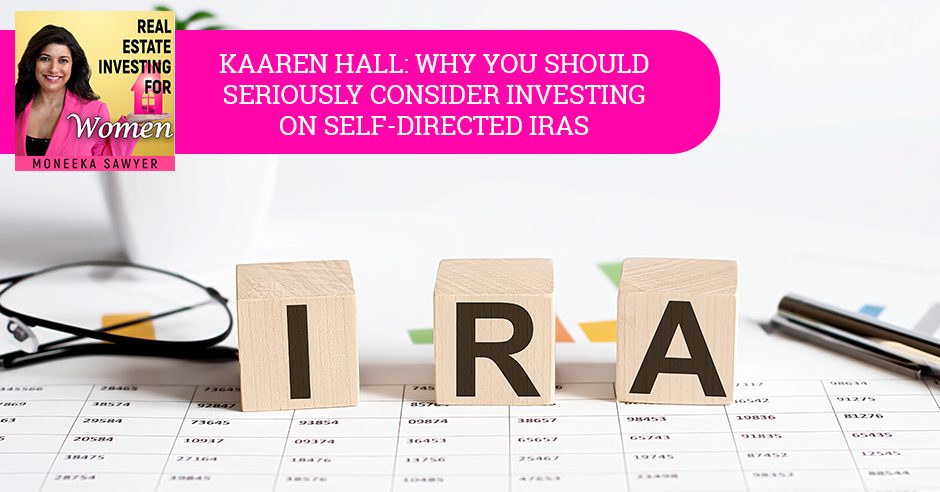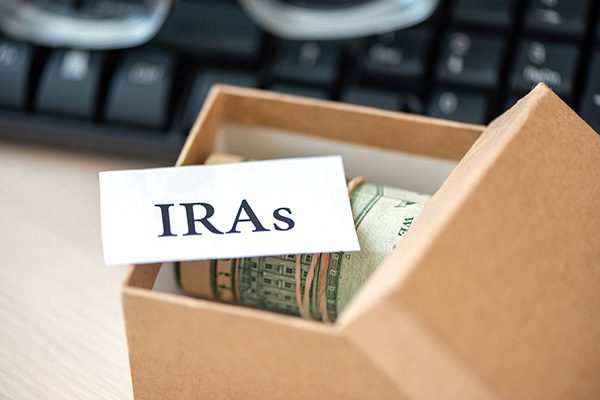Kaaren Hall: Why You Should Seriously Consider Investing On Self-Directed IRAs – Real Estate For Women

How convenient is it to invest in an asset of your own choosing, write a personal check to that investment, with the bank simply there just to facilitate? That’s exactly how self-directed IRAs work, and it allows you to tap into a massive pool of funds if done correctly. Moneeka Sawyer sits down with Kaaren Hall, CEO at uDirect IRA Services. Together, they dissect the many benefits of self-directed IRAs, as well as the intricacies that come with it. Moneeka and Kaaren explain how to invest 401(k) tax-deferred money properly, why you are still getting taxed by the IRA, what happens when you exceed the expenditures buffer, and a lot more.
—
Watch the episode here
Listen to the podcast here
Kaaren Hall: Why You Should Seriously Consider Investing On Self-Directed IRAs – Real Estate For Women
Real Estate Investing For Women
I am so excited, ladies, to welcome back to the show Kaaren Hall. For you, ladies, who don’t remember her, she’s amazing. Here’s her bio to remind you. Despite being in the midst of a recession and mortgage market collapse, Kaaren Hall founded and made a resounding success of uDirect IRA Services. She discovered a strategic way to put her twenty-plus years in mortgage banking, real estate and property management to use. The solution was an untapped market for both her skills and for investors, self-directed IRAs. Through uDirect IRA, she has guided tens of thousands of Americans through the process of diversifying their investments using self-directed IRAs. Kaaren, welcome back.
It’s great to see you. It’s been a while.
You look gorgeous, by the way. Kaaren, last time we talked in-depth about the self-directed IRAs. I’d like to give a higher-level version of that conversation to remind people what your company does. There are a lot of different self-directed IRAs. What is it that yours specializes in?
With self-directed IRAs, it’s the traditional, Roth, SEP, SIMPLE, inherited IRA. We also offer the solo 401(k) and that’s for self-employed people who have no full-time employees in any of the companies that they own. We also offer the self-directed HSA or Health Savings Account and that’s a different piece altogether. These are the accounts that we offer. What we do all day besides helping people is we’re customer service. We help people a lot. We talk to people and walk them through the process. We’ll say, “Tell me what you’re looking to invest in. What are you going to do? Who are the people that are investing with you?” We’re screening for prohibited transactions. Those are one of the many things that we do.
Define self-directed again. I know that you’ve done this before but do it again. People have this impression of what self-directed means.
To understand, an IRA is an IRA. It’s a bucket that holds assets. Whether it’s over at Charles Schwab or at some financial management company or it’s self-directed, the rules are the same. The only difference is the asset class that’s held inside that account. The account itself, the rules are all the same. With a self-directed IRA, it holds alternative assets sometimes called non-correlated assets. There are different names for them but it’s like real estate, metals, notes and things like that.
Ladies, I know that many of you have 401(k)s and your 401(k) is if you’re a W-2 employee or maybe you’ve even got your personal ones, your SEP IRA, all of that stuff for your business. Maybe you have what’s called a self-directed 401(k). Take a look at what that means because there are different kinds of self-directed. A lot of times, what a self-directed 401(k) or IRA means by normal terms is you are in an account where you can choose any of the 200 funds run by this particular company that is the custodian of your 401(k).

Self-Directed IRAs: You can buy a performing and non-performing debt. People do it all the time. Your IRA can also be the bank and lend money to people in situations.
For instance, if you’ve got Fidelity, Vanguard, Schwab or one of these guys, they do say that they’re self-directed but they’re self-directed with limits. They say, “You can self-direct into funds. You can do mutual funds, bond funds or REITs.” There are some things that you can do but you’re limited based on the products that they offer. That’s how they’re defining self-directed.
Kaaren is defining this differently. She says, “We’re a custodian.” You can take that and again, it is within a limit. Usually, you can’t do collectibles or paintings. There are still limits about what you can’t do but there’s a much larger range of what you can do. You can do real estate, precious metals, a few different things. Kaaren is going to give us more clarity on some of those asset classes but I wanted to define for you the difference between self-directed according to what a lot of financial institutions are calling and self-directed like how Kaaren is defining it. Did I get that right, Kaaren?
You did. You understand it perfectly. They’re assets that, as our name implies, you direct. We’re not choosing the asset for you. It’s like if you had a checking account and you wanted to invest and so you wrote a personal check from your bank and you sent that check to the investment. The bank is there to facilitate your transaction. uDirect IRA Services is a third-party administrator. We use the services of a trust company custodian we’ve been a partner with or working in alliance with for several years now. It zips on through the same way. It’s administrative and not advisory.
Let’s get into asset classes because this is one of those things that we haven’t discussed on this show. I’d like to get a deeper understanding myself and also for my ladies about what those asset classes are and what investing in them looks like.
The number one asset class is real estate. When I started uDirect IRA Services in 2009, it was in the middle of a recession. You probably still are holding onto some of these assets or maybe you sold them all but you can buy houses on tape. Remember those days? In 2009, self-directed IRAs exploded in the real estate investor market because real estate investors didn’t have access to capital. Banks weren’t lending. When it comes to real estate as an asset class, self-directed IRAs came more to the forefront at that time. Again, you could buy foreclosures. Everyone was a flipper, it seems like. Now, when I’m out speaking, I ask people who’s a flipper, not so many people. They’re different. You always have to be like Sniff and Scurry in Who Moved My Cheese. When you’re in real estate, you have to be able to move with your cheese.
That’s how it was then. Real estate could be brick and mortar. It can even be private placements, which are like syndications. Perhaps you know someone who’s trying to raise capital to build a very large apartment complex. They don’t have all the capital themselves. They have some. They get financing and then they also use self-directed IRAs as part of that whole package to close on that deal. A self-directed IRA can be an equity partner in a deal like that into a private placement, also called a syndication, sometimes crowdfunding. It’s the same name for the same thing, private stock.
All real estate expenses have to be paid for by the IRA. The only difference is how and where you are investing it. Share on XThat’s another way where it’s still correlated to real estate but it’s a different vehicle. Usually, when people invest, it’s debt or equity. When you’re investing, either you’re loaning money or you’re becoming an equity member or shareholder of that situation. Real estate, you can get into other real estate assets like raw land.
Now you have the caveats about raw land. You have to make sure that you own the whole parcel because if you own part of a parcel and there’s one tax ID but two people own that parcel, usually the tax collectors won’t take that tax check unless you have the whole tax amount in the same envelope. Little nuances about every single asset class. Real estate can be straight-up brick and mortar. It could be private placements, raw land, multifamily, anything that is real estate related. That goes onto the next topic, which is still real estate-related and those are notes. Do you know?
You can buy a performing and non-performing debt. People do it all the time. Your IRA can also be the bank and lend money to people in situations. Maybe they know someone who needs a bridge loan because they’re moving and they haven’t sold their house yet. Your IRA can lend money to people. It can be secured and unsecured debt that an IRA can lend. It can be the bank and lend money and then it can also be an investor buying secured and unsecured notes and get them reperforming or enjoy that continued performance.
There’s the precious metals field. A lot of people love precious metals. It’s that tangible, touchable asset. When it’s in a self-directed IRA though, you’re not going to hold onto it. It’s going to be in custody for you. We custody the assets at Delaware Depository and they will hold the actual metal for us and for your account so that you have the metal, the coins. For example, you say, “I want all those coins. I want to hold them.” You would take a taxable distribution and we would send the coins to you if that’s what you wanted to do. Otherwise, it can stay there in your account being held and hopefully growing in value because that’s the game. We want to win that game. Some of the asset classes there though.
Someone said something interesting to me and I’ve never had an opportunity to have this conversation. I know I’m going to put you on the spot a little bit here but I also know you’re up to it. I was talking to another investor and he said, “I would never invest my 401(k) tax-deferred money into another tax-deferred asset like real estate because then you lose the benefit on one side or the other.” What do you have to say to that?
I say your friend is right. That’s true. Here’s why you do want to use a self-directed IRA. If you have a whole pile of cash or a great credit score, you’re going to do this personally with brick and mortar real estate, you get incredible write-offs. You get great tax deals. If you’ve got the money in your IRA and the money personally, “What to do? I have found this great piece of property I want to take down. Which one should I use?”

Self-Directed IRAs: When your IRA is acquiring a piece of real estate and you need leverage to do it because you want to have 100%, you can’t go take a loan from a bank.
You talk to your tax person and you will probably come to the conclusion that, “Maybe doing it personally is going to give me more tax benefit.” That’s entirely possible but like with any investment you do, you get it down on paper, you’ll look at your deal from beginning to end, acquisition costs, holding costs, liquidation costs. What are you going to net at the end? You always want to write it down on paper.
There could be a different question and this is when the self-directed IRA comes in. Maybe you don’t have a lot of cash on hand. Maybe the bulk of your assets is your 401(k) from where you used to work, for example. You roll that tax-deferred money into a self-directed IRA. That IRA acquires a property and now all the proceeds from that asset like rent or proceeds from a sale are tax-deferred. They can be tax-free in a Roth as well. You can maximize that benefit. You’re not going to get write-offs.
All the expenses of real estate have to be paid for by the IRA. All the expenses of any IRA asset have to be paid for. Similarly, all proceeds have to go back into the IRA. That’s one way to look at it. An IRA can be the way to go with real estate for that reason. You’ve got the money. Where are you going to put it, in the stock market, in Wall Street or Main Street? That’s when it makes sense.
When you have the assets then that’s where you can invest them.
That’s the long way. You summed it up perfectly.
The other question is, normally with real estate, when we do it privately we leverage. We might put 20% down and then we get a loan on the rest of it. Talk to me about that equivalent in doing it in your retirement account.
What you bring up is our number one most misunderstood thing about a self-directed IRA, debt. I’m glad you brought this up because I love to provide some clarity. There’s a lot of confusion. Here’s the thing. I come from the residential mortgage world. I spent a lot of time there. When I found out that a bank or an institution will make a loan to an IRA account and not an individual, I was completely surprised. That’s how it works. When your IRA is acquiring a piece of real estate and you need leverage to do it because you want to have 100%, you can’t go take a loan from a bank.
Your IRA cannot go get a Fannie and Freddie, conventional or conforming FHA loan. The reason is that there’s no recourse against the IRA but your IRA can borrow money. It still can borrow money like a commercial loan called a non-recourse loan. If anybody who’s reading wants a copy of my list of non-recourse lenders, it’s not a list that we necessarily recommend but it’s hard to find everybody so we put them on one piece of paper. I’ll share it. Email me, [email protected] if you want that.
If you are just starting in real estate investing, do due diligence and talk to everybody. Get as much free advice as you can. Share on XYour IRA takes on this debt. What are the parameters or what does it look like? You can ask the lenders and they’ll tell you their underwriting guidelines. Usually, they want IRA to have a little more skin in the game when they’re doing this. For example, your IRA finds a house that’s $100,000. Your IRA has $70,000 and then you borrow another $30,000 so you have enough. One of the things you want to think about here because you’re acquiring real estate is do you have a pad for expenses?
If you have property, keep a 10% pad for things like property taxes, the water heater broke or something. You’re always going to have expenses with real estate so have a pad for expenses. For example, you take $70,000 of your IRA money, $30,000 of this non-recourse debt and you buy the house. Your 70% is IRA money, 30% is debt.
Here comes your rent check, say it’s $1,000. $700 IRA earned because of saving and $300 your IRA earned because of leverage because you borrowed money. That $300 that your IRA received because of leverage is taxable to the IRA. The IRA can sometimes pay tax. This is called UDFI, Unrelated Debt-Financed Income tax. You can read about it at IRS.gov, Publication 598. Like you and I, we do 1040 when we do our personal taxes and IRA files a 990-T. Your tax person helps figure out if you could take deductions or whatever and then your IRA would pay any tax if any is due. That is how that works.
That’s interesting. When you look at that, 70% was paid because you put 70% in and that’s going to go on for however long you hold the property. The debt piece, if you make a profit or if you bring in money for that debt piece, you get taxed on it. That’s confusing to me. Why are you getting taxed in your IRA? The whole point is to be able to make profits on this and have it grown. That’s why you have it in an IRA.
Sometimes you have so many expenses that there is no tax. You still have to take a look at it and see if there is but it’s called unrelated debt-financed income tax. The debt is not related to savings. Think about when you’ve got an IRA, you’ve got a cap on how much you can put in there. Borrowing a whole bunch of money is like a contribution. The tax-protected money is what you save with your contribution. The debt is something unrelated.
The way I heard it explained originally, it goes back to, for example, the Catholic church. For example, the Catholic church, which is a tax-exempt entity and this is some case going back a while ago. Let’s say they have a bakery, it’s on their land and they’re tax-exempt. They’re selling baked goods. Somebody opens a bakery across the street. They have to pay all kinds of taxes.
The church, being a tax-exempt entity, isn’t going to pay as much. In that sense, it’s not fair competition. That’s the origination of these taxes. It’s not just IRAs but it’s tax-exempt entities. I believe that non-profit organizations file 990-T as well. It’s a way to create parity between the different kinds of entities that are doing the same thing. That’s how it originated but it is still due. Those were a couple of reasons why it exists.

Self-Directed IRAs: Borrowing money is like a contribution. The tax-protected money is what you save with your contribution. The debt is something unrelated.
That’s interesting. I’ve never heard of that before. Thank you so much for sharing that. Ladies, if you want to get that list of the non-recourse lenders, it’s at [email protected]. That’s how to get that. How big is that list? I heard there were only four lenders that do that.
There are more than four, probably half a dozen. There may be four big ones. I can think of a big one in particular that’s national. They’re not all national. We have a list of several different lenders and you can see what region you’re in, what region they’re in and what makes the most sense for you.
One of the things you talked about is that you want to make sure that you have a buffer for maintenance, for taxes or insurance. There are bills that come up each year. You want to make sure that you have some buffer in your account. Let’s say you’re investing that $70,000. You should have a $100,000. That’s what I would do because I’m super conservative. I know others will do other things but I keep a nice buffer. What happens if the expenses exceed that buffer and you have to now pay expenses outside of the IRA?
There are resolutions. There are ways to solve that problem. The first plan of attack may be to write a check and make a contribution to your IRA or your 401(k), which you can do if you have earned income. Again, it depends upon your age, your account type and your income, how much you can contribute. Probably the first line is to write a check out of your personal account, contribute it to your IRA and have your IRA pay the bill, maybe it’s tax, repairs or something.
The second level may be to say that you probably have a portfolio with assets in different places. A lot of people like to be diversified. Maybe sell some of the stocks, bonds and mutual funds that you have at another institution. Liquidate them, move them over to the self-directed IRA and use that capital to make up the shortfall.
Your IRA could also take on debt in a non-recourse fashion. We talked before about qualified and disqualified people. Disqualified people, your lineal ascendants and descendants, you and your spouse, your parents and grandparents, children and grandchildren are disallowed to the IRA, plus a 50/50 business partner and any fiduciary to the plan.
Those people could not lend to your IRA but other people could like your next-door neighbor or your cousin. They could go ahead and lend to your IRA. That’s how you would make up a shortfall. If all else fails, you’d have to sell the asset. Sometimes we come into assets especially real estate with expenses, something has a big issue and you have to liquidate. That is another option as well.
Real estate is a moving target. Stay on top of it at all times if you want to find success. Share on XThe next piece is let’s say I’m 59 1/2. I’ve got this piece of property that’s not liquid. What do we do because, according to law, we’ve got to start taking money out?
Good news. 59 1/2 is a good age because when you turn 59 1/2 and thereafter, you can take money out of your pre-tax IRAs, the kind where you’ve got a tax reduction, like the traditional, the SEP, the SIMPLE IRA, the 401(k) without a penalty. That’s the 59 1/2 buffer right there. Now you can take your money out penalty-free, still being taxed.
What you’re talking about and correct me if I’m wrong, is when you reach 70 1/2. It used to be 70 1/2, now it’s 72. After 2021, it could be 75. We might see that when Congress meets at the end of the year and they discuss all these changes they have proposed to the retirement system, most of which are awesome. It’s called the RMD, Required Minimum Distribution. We have articles about this on the uDirect website. If you like to read about them, you can go to our search bar, type RMD and there are articles. When you reach, it’s 72 1/2 then you begin to take your RMD. You take your age and then you go on the IRS website, they have a table. You multiply your savings times this factor and that’s the minimum you have to borrow.
A couple of things, I was researching RMDs. If you don’t take your RMD now, there is a 50% penalty for not taking it. In other words, 50% of what your RMD should have been will be the penalty. That’s how it is. With the new laws that are looking to come out, they may rescind that penalty altogether. They may reduce that penalty to 25%. That’s what might happen. What is true now is that if there’s some good reason why you didn’t take your RMD, if you’re hospitalized or something that was beyond you, some act of God or something then you can tell the IRS.
They didn’t used to have this leniency. There is a method to communicate with them like, “I didn’t take my RMD. Here’s a really good reason why,” and then you get a get out of jail free card. Those are good things to know about these required minimum distributions because the IRS gives you a tax break upfront for making your contributions but later on you have to pay the piper, usually when you’re older. That’s how it works.
That makes a lot of sense when you have liquid assets but you’ve got this big property in there. It’s not liquid. How do you take those distributions?
In theory, you could get an evaluation every year and disburse a fraction, a percentage of the assets to yourself but that isn’t practical. The reason is because your IRA has to pay for that annual evaluation, which is probably about $600 if it’s an appraisal. It ends up not being cost-effective to do that yearly. Typically, when people are reaching that RMD age, they will either liquidate the property, just sell it or you can disburse the entire house to yourself as an asset and then you’ll get 1099 on the value of that asset.
You provide evaluation, you complete a non-cash withdrawal, which we will help you with and then the title and the ownership of that property can be reverted to you as a person and then your 1099 for the value of the transfer. That’s two ways, liquidate or take it as an asset. Either way it involves tax so it’s a good idea to have that planned ahead of time.

Self-Directed IRAs: A debt piece creates parity between different kinds of entities that are doing the same thing.
The other plan is to have so many other IRA accounts or money in different IRAs, where you’ve got a lot of cash or liquidity that you have enough liquid assets in your retirement qualified funds and in your retirement accounts to take those RMDs and retain the property. That’s another way to go. Three different views.
When you sell it or liquidate it within the IRA, you don’t have to go through the whole 1031?
No, they are different universes. The qualified funds are this little universe over here, 1031 is over here. They’re different bubbles so you don’t 1031.
You don’t pay your capital gains on that. You don’t have the recapture of depreciation. You don’t have all of those pieces. Is that true?
It is true. You can also ask your tax advisor since, technically, we don’t give tax advice but it is true. If you have recapture of depreciation, that’s not fun.
That’s a reason to invest in a tax-deferred asset in a 401(k) because then you can get out of it without having to be all of those capital gains that you would normally, “1031. How do we get away from paying all of these taxes?”
By the way, I’ll be doing a brunch with the Norris Group and with a 1031 exchange commentator. We’ll talk about the times and the technicalities of some terms on the IRA and 1031 can merge. If you want, go to our website and sign up for our newsletter and then you’ll get an email. We send our weekly emails talking about the events that we participate in. I will send you an email telling you about that event coming up on October 30, 2021.
That is a perfect segue. Why don’t you tell how they can find out more information?
We’re all over social media. If you want to network with other self-directed IRA people, do it out there. It’s great. All the classics, Facebook, Instagram and LinkedIn and all these different social media outlets, you can find us there. At our website, UDirectIRA.com. We have years of blog articles that can provide some clarity to your self-directed IRA investing questions. We’ve got links to the IRS and where they go deep on different issues so you can learn more that way. Also, you can find our contact information. Pick up the phone and call us. Talk to us and tell us what your questions are and we’ll work with you.
I love that. The email address is [email protected]. Ladies, you can get that list of non-disclosure lenders from there also. Thank you, Kaaren. Are you ready for our three rapid-fire questions?
I don’t know. Let’s go.

Self-Directed IRAs: In theory, you could get an evaluation every year and disburse a percentage of the assets to yourself, but that isn’t practical.
Give us a super tip on getting started investing in real estate.
Do due diligence and talk to everybody. Ask them and get advice. If you’re getting started, you can do it for free. People will give you free advice. Real estate investors are the nicest people I’ve ever met for the most part. They want to help you. Listen to people. Before you invest, do all your homework.
I love that. What is one strategy for being successful in real estate investing?
Stay on top of it because it’s a moving target. There are so many different moving pieces when it comes to real estate, like your value, your tenants. I don’t advise about real estate investing but what I see when it’s in a self-directed IRA, what you want to do is stay on top of that by looking at your self-directed IRA accounts. Make sure that you see that monthly check going in every month, that rent if you’ve got a rental property or if IRA has lent money, that note payment is coming back in every month. Go into your account. We give you a PDF, you can download the PDF of your monthly statement every month. Save it in your files because we don’t keep them forever. Save all that and be good about your bookkeeping. That would be great.
What is one daily practice that you do that you would say contributes to your personal success?
Two things. One thing I don’t do every day but most days is I exercise. I have to go to the gym. That’s energy and vitality. You got to get the blood moving and the body likes it when blood circulates. I like that, it keeps me awake. That’s great. Also, meditation and prayer are good to put me in a thoughtful space before I start my day. To start my day with intention is helpful.
This has been so informative. I’ve never gotten to ask those particular questions about self-directed IRAs. Thank you.
I’m glad.
Ladies, thank you for joining Kaaren and I for this portion of the show. I look forward to seeing you next time. Until then, remember, goals without action are just dreams so get out there, take action and create the life your heart deeply desires. I’ll see you soon. Bye.
Important Links
- uDirect IRA Services
- [email protected]
- Who Moved My Cheese
- IRS.gov
- Facebook – uDirect IRA Services
- Instagram – uDirect IRA Services
- LinkedIn – uDirect IRA Services
About Kaaren Hall
 uDirect IRA Services has helped thousands of Americans invest their IRA outside of the stock market into real estate, land, private notes & more to improve their financial future. Educating individual investors and professionals is the cornerstone of uDirect IRA. We have events right here in Southern California geared toward self-directed investing. We also offer webinars so no matter where you are you can “Learn to Earn”. uDirect IRA is a third-party administrator providing complete and accurate information on self-directed IRAs so you can make the most of your retirement funds. We do not promote any investments. Rather, we provide the knowledge, tools and information you need to make self-direction easy. At uDirect, we help you get started quickly and easily, and stay with you every step of the way.
uDirect IRA Services has helped thousands of Americans invest their IRA outside of the stock market into real estate, land, private notes & more to improve their financial future. Educating individual investors and professionals is the cornerstone of uDirect IRA. We have events right here in Southern California geared toward self-directed investing. We also offer webinars so no matter where you are you can “Learn to Earn”. uDirect IRA is a third-party administrator providing complete and accurate information on self-directed IRAs so you can make the most of your retirement funds. We do not promote any investments. Rather, we provide the knowledge, tools and information you need to make self-direction easy. At uDirect, we help you get started quickly and easily, and stay with you every step of the way.
Despite being in the midst of a recession and mortgage market collapse, Kaaren Hall founded and made a resounding success of uDirect IRA Services. The single mom discovered a strategic way to put her 20+ years in mortgage banking, real estate and property management to use. The solution was an untapped market for both her skills and for investors – self-directed IRAs.
Because self-directed IRAs can have a dramatic impact on retirees’ quality of life, Hall brings her full passion to educating Americans about the little-known investment vehicle. She has educated tens of thousands of investors and professionals on how to build wealth by taking control of self-directed IRAs.
She says, “Financial literacy is not taught in schools, but our future depends on understanding it. Only about 4% of U.S. investors have a self-directed IRA. Why? Because most investors and many advisors simply aren’t aware of it.”
Prior to her years at Bank of America, Indymac Bank and Hall’s own mortgage brokerage experience, she was an on-air news and traffic reporter and radio host. Now Hall broadcasts how to invest IRAs in real estate, land, startups and more. She takes pleasure in demystifying the subject via webinars, YouTube videos, live events, social media and her free weekly newsletter.
Moneeka Sawyer is often described as one of the most blissful people you will ever meet. She has been investing in Real Estate for over 20 years, so has been through all the different cycles of the market. Still, she has turned $10,000 into over $5,000,000, working only 5-10 hours per MONTH with very little stress.
While building her multi-million dollar business, she has traveled to over 55 countries, dances every single day, supports causes that are important to her, and spends lots of time with her husband of over 20 years.
She is the international best-selling author of the multiple award-winning books “Choose Bliss: The Power and Practice of Joy and Contentment” and “Real Estate Investing for Women: Expert Conversations to Increase Wealth and Happiness the Blissful Way.”
Moneeka has been featured on stages including Carnegie Hall and Nasdaq, radio, podcasts such as Achieve Your Goals with Hal Elrod, and TV stations including ABC, CBS, FOX, and the CW, impacting over 150 million people.

